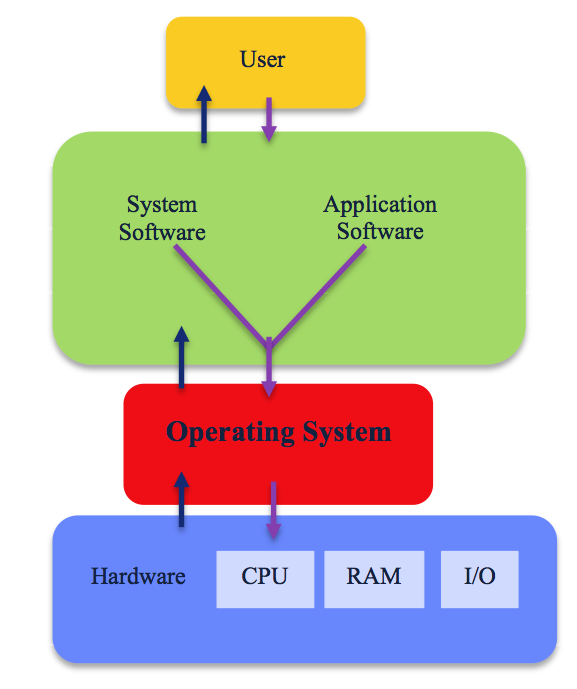In simple terms, an operating system is an interface between the computer user and the machine. It is very important for you that every computer must have an operating system in order to run other programs. The operating system mainly coordinates the use of the hardware among the various system programs and application programs for various users. Operating system (OS), program that manages a computer ’s resources, especially the allocation of those resources among other programs. Typical resources include the central processing unit (CPU), computer memory, file storage, input/output (I/O) devices, and network connections. Apr 01, 2021 What Is the Purpose of an Operating System? Operating systems contain and manage all the programs and applications that a computer or mobile device is able to run, which means managing the device’s software and hardware functions. The functions of an OS include. Knowing what operating system is running on your computer, smartphone, or tablet help you troubleshoot issues and know your computer's or device's compatibilities. Below are the steps on how to determine what operating system is running on your computer, smartphone, or tablet. What is Operating Systems? The operating system (OS) allows users to perform the basic functions of a computer. The OS manages all software and peripheral hardware, and accesses the central processing unit (CPU) for memory or storage purposes. It also makes it possible for a system to simultaneously run applications.
An operating system is an important part of a computer system. A computer system is built from three general components: the hardware, the operating system, and the applications. The hardware includes pieces such as a central processing unit (CPU), a keyboard, a hard drive and a printer. You can think of these as the parts you are able to touch physically. Applications are why you use computers; they use the rest of the system to perform the desired task (for example, play a game, edit a memo, send electronic mail). The operating system is the component that on one side manages and controls the hardware and on the other manages the applications.
When you purchase a computer system, you must have at least hardware and an operating system. The hardware you purchase is able to use (or run) one or more different operating systems. You can purchase a computer package, which includes the hardware, the operating system, and possibly one or more applications. The operating system is necessary in order to manage the hardware and applications.
When you turn on your computer, the operating system performs a series of tasks, presented here in chronological order.
One of the first things you do, after successfully plugging together cables and components, is turn on your computer. The operating system takes care of all the starting functions that must occur to get your computer to a usable state. Various pieces of hardware need to be initialized. After the start-up procedure is complete, the operating system awaits further instructions. If you shut down the computer, the operating system also has a procedure that makes sure all the hardware is shut down correctly. Before turning your computer of again, you might want to do something useful, which means that one or more applications are executed.
After the operating system completes hardware initialization, you can execute an application. The executing application is called a process. It is the operating system’s job to manage execution of the application. When you execute a program, the operating system creates a new process. Many processes can exist simultaneously. This process is referred to as multitasking. When you exit your program (or it finishes executing) the process terminates, and the operating system manages the termination by reclaiming any resources that were being used. Most applications perform some tasks between the time the process is created and the time it terminates. To perform these tasks, the program makes requests to the operating system, and the operating system responds to the requests and allocates necessary resources to the program. When an executing process needs to use some hardware, the operating system provides access for the process.
To perform its task, a process may need to access hardware resources. The process may need to read or write a file, send data to a network card (to communicate with another computer), or send data to a printer. The operating system provides such services for the process. This is referred to as resource allocation. A piece of hardware is a resource, and the operating system allocates available resources to the different processes that are running.
All computers do not use the same operating systems. It is therefore important to assess the operating system used on a particular model before initial commitment because some software is only designed to run under the control of specific operating systems. Some operating systems are adopted as ’’industry standards’’ and these are the ones which should be evaluated because they normally have a good software base. The reason for this is that software houses are willing to expand resources on the development of application packages for machines functioning under the control of an operating system which is widely used. The cost of software is likely to be lower in such circumstances as the development costs are spread over a greater number of users, both actual and potential.
Mainframe computers usually process several application programs concurrently, switching from one to the other, for the purpose of increasing processing productivity. This is known as multiprogramming, which requires a powerful operating system. An operating system is stored on disk and has to be booted into the internal memory (RAM) where it must reside through processing so that commands are instantly available. The operating system commands may exceed the internal memory capacity of the computer in which case only that potion of the operating system which is frequently used is retained internally, other modules being read in from disk as required.
Vocabulary Notes
to edit– редагувати
memo– повідомлення, пам’ятка
to manage-керувати,управляти,організовувати процес (координувати)
to occur[q'kW]–відбуватися, траплятися
to complete –завершувати, закінчувати
simultaneously['sIm(q)l'teInslI]–одночасно
multitasking –виконання значної кількості завдань одночасно
to terminate -завершувати
termination –завершення
to reclaim –відновлення
a request[rI'kwqst]–запит
to allocate –розміщувати
allocation -розміщення
to access['xkses] –отримати (мати)доступ
to assess['xses] –оцінювати

initial commitment –первинне встановлення
to adopt –приймати, переймати, засвоювати
to evaluate –оцінювати, обчислювати, визначати якість
to will –заставляти, примушувати
to expand –розширювати, розповсюджувати
concurrently[kqn'kAr(q)ntlI]–одночасно
to boot –початкове завантаження системи, самозавантаження
instantly –негайно
to reside[rI'zaId]–постійно зберігатися
to exceed [Ik'sJd]– переповнювати, перегружати
to retain –утримувати в пам’яті, акумулювати
Lesson 8: Understanding Operating Systems
/en/computerbasics/mobile-devices/content/
What is an operating system?
An operating system is the most important software that runs on a computer. It manages the computer's memory and processes, as well as all of its software and hardware. It also allows you to communicate with the computer without knowing how to speak the computer's language. Without an operating system, a computer is useless.
Watch the video below to learn more about operating systems.
Operating System Concepts
Looking for the old version of this video? You can still view it here.
The operating system's job
Your computer's operating system (OS) manages all of the software and hardware on the computer. Most of the time, there are several different computer programs running at the same time, and they all need to access your computer's central processing unit (CPU), memory, and storage. The operating system coordinates all of this to make sure each program gets what it needs.
Types of operating systems
Operating systems usually come pre-loaded on any computer you buy. Most people use the operating system that comes with their computer, but it's possible to upgrade or even change operating systems. The three most common operating systems for personal computers are Microsoft Windows, macOS, and Linux.
Modern operating systems use a graphical user interface, or GUI (pronounced gooey). A GUI lets you use your mouse to click icons, buttons, and menus, and everything is clearly displayed on the screen using a combination of graphics and text.

Each operating system's GUI has a different look and feel, so if you switch to a different operating system it may seem unfamiliar at first. However, modern operating systems are designed to be easy to use, and most of the basic principles are the same.
Microsoft Windows
Microsoft created the Windows operating system in the mid-1980s. There have been many different versions of Windows, but the most recent ones are Windows 10 (released in 2015), Windows 8 (2012), Windows 7 (2009), and Windows Vista (2007). Windows comes pre-loaded on most new PCs, which helps to make it the most popular operating system in the world.
Check out our tutorials on Windows Basics and specific Windows versions for more information.
Operating System Software
macOS
macOS (previously called OS X) is a line of operating systems created by Apple. It comes preloaded on all Macintosh computers, or Macs. Some of the specific versions include Mojave (released in 2018), High Sierra (2017), and Sierra (2016).
According to StatCounter Global Stats, macOS users account for less than 10% of global operating systems—much lower than the percentage of Windows users (more than 80%). One reason for this is that Apple computers tend to be more expensive. However, many people do prefer the look and feel of macOS over Windows.
Check out our macOS Basics tutorial for more information.
List Of Smartphone Operating Systems
Linux
Linux (pronounced LINN-ux) is a family of open-source operating systems, which means they can be modified and distributed by anyone around the world. This is different from proprietary software like Windows, which can only be modified by the company that owns it. The advantages of Linux are that it is free, and there are many different distributions—or versions—you can choose from.
According to StatCounter Global Stats, Linux users account for less than 2% of global operating systems. However, most servers run Linux because it's relatively easy to customize.
To learn more about different distributions of Linux, visit the Ubuntu, Linux Mint, and Fedora websites, or refer to our Linux Resources. For a more comprehensive list, you can visit MakeUseOf's list of The Best Linux Distributions.
Operating systems for mobile devices
The operating systems we've been talking about so far were designed to run on desktop and laptop computers. Mobile devices such as phones, tablet computers, and MP3 players are different from desktop and laptop computers, so they run operating systems that are designed specifically for mobile devices. Examples of mobile operating systems include Apple iOS and Google Android. In the screenshot below, you can see iOS running on an iPad.
Operating systems for mobile devices generally aren't as fully featured as those made for desktop and laptop computers, and they aren't able to run all of the same software. However, you can still do a lot of things with them, like watch movies, browse the Web, manage your calendar, and play games.
To learn more about mobile operating systems, check out our Mobile Devices tutorials.
/en/computerbasics/understanding-applications/content/
